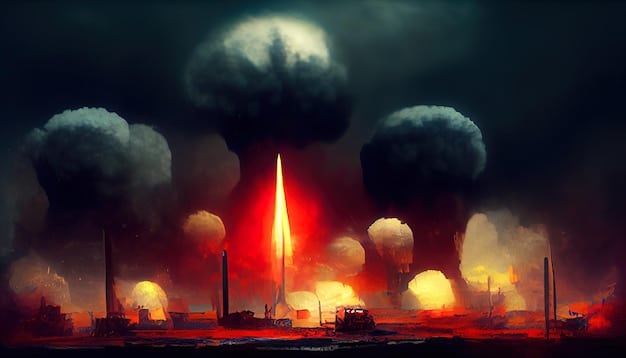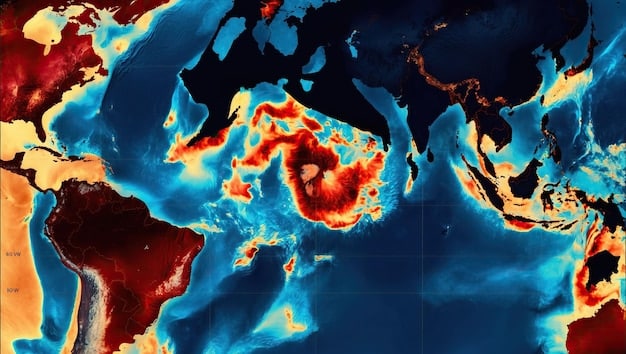The US and Nuclear Disarmament: A Realistic Future Assessment

The US and the future of nuclear disarmament involves navigating complex geopolitical landscapes, technological advancements, and evolving security doctrines to achieve a world with fewer nuclear weapons, while addressing deterrence and global power dynamics.
The pursuit of nuclear disarmament is a complex and multifaceted challenge, especially when considering The US and the future of nuclear disarmament: A realistic assessment. The United States’ role is critical due to its historical involvement, current nuclear arsenal, and influence on international security.
Understanding Nuclear Disarmament
Nuclear disarmament refers to the process of reducing or eliminating nuclear weapons. It is a long-standing goal of many countries and international organizations, aiming to enhance global security and prevent nuclear war. The United States has been a key player in this arena, both as a developer of nuclear weapons and as a participant in disarmament efforts.
However, achieving complete nuclear disarmament is a daunting task that requires overcoming numerous political, technological, and strategic obstacles. A thorough understanding of the historical context, current challenges, and potential pathways is essential for a realistic assessment.
Historical Context
The history of nuclear disarmament is marked by periods of intense activity and frustrating stagnation. The Cold War saw a massive buildup of nuclear arsenals, followed by landmark treaties such as the Strategic Arms Reduction Treaty (START). These treaties reduced the number of deployed nuclear warheads, but the overall threat remained significant.
After the Cold War, there was renewed optimism about further disarmament. Nations dismantled obsolete weapons and pledged continued reductions. However, this momentum has waned in recent years, with new concerns about nuclear proliferation and modernization.
Current Challenges
Several challenges impede the path to nuclear disarmament. These include:
- Geopolitical Tensions: Rising tensions between major powers, such as the United States, Russia, and China, make disarmament negotiations difficult. Mistrust and competition often overshadow cooperation.
- Nuclear Proliferation: The spread of nuclear weapons to additional countries increases the risk of nuclear war. Preventing further proliferation is a critical but complex task.
- Modernization Programs: Many countries are investing in modernizing their nuclear arsenals, raising concerns about a new arms race. These programs can undermine disarmament efforts.
- Verification Issues: Ensuring compliance with disarmament treaties is challenging. Verification requires intrusive inspections and monitoring, which can be politically sensitive.
These challenges require careful consideration and innovative solutions to move toward a more secure world.
In conclusion, understanding nuclear disarmament involves acknowledging its historical context and the current challenges that hinder its progress. By addressing these issues, we can work towards a safer future.
The US Stance on Nuclear Disarmament
The United States’ stance on nuclear disarmament has evolved over time, influenced by changing geopolitical dynamics and domestic political considerations. Historically, the US has supported disarmament efforts through treaties and initiatives, but recent administrations have adopted a more cautious approach.
Understanding the nuances of US policy, its alignment with other nations, and the domestic factors influencing it is crucial for assessing the future of disarmament.

Treaties and Commitments
The US has a long history of engaging in arms control treaties. The US has been a party to several key agreements, including the Nuclear Non-Proliferation Treaty (NPT) and the various START treaties. These agreements have played a significant role in reducing the global nuclear stockpile.
However, the US has also withdrawn from some agreements. The US withdrawal from the Intermediate-Range Nuclear Forces (INF) Treaty in 2019, citing Russian non-compliance, raised concerns about a potential new arms race.
Current Policies
Under recent administrations, the US has emphasized nuclear deterrence and maintaining a credible nuclear arsenal. The policy has focused on modernizing existing weapons systems rather than pursuing further reductions. This approach reflects concerns about the nuclear capabilities of other countries, especially Russia and China.
These policies are often justified by the need to deter potential adversaries and ensure the security of the US and its allies. However, critics argue that they undermine disarmament efforts and increase the risk of nuclear conflict.
Domestic Influences
Domestic politics play a significant role in shaping US nuclear policy. Factors influencing US policy include:
- Public Opinion: Public attitudes toward nuclear weapons and disarmament can influence policy decisions. Generally, there is broad support for reducing the risk of nuclear war, but opinions vary on how to achieve this goal.
- Congressional Oversight: Congress plays a critical role in funding and overseeing nuclear programs. Congressional support is essential for any major policy change related to disarmament.
- Defense Industry: The defense industry has a vested interest in maintaining nuclear programs. Lobbying efforts can influence policy decisions and funding allocations.
Ultimately, the future of US nuclear policy will depend on a complex interplay of these factors.
In conclusion, the US stance on nuclear disarmament is shaped by a combination of historical commitments, current policies focused on deterrence, and domestic influences. By understanding these elements, we can better evaluate the future prospects for disarmament.
Geopolitical Factors Affecting Disarmament
Geopolitical factors play a crucial role in shaping the prospects for nuclear disarmament. The relationships between major powers, regional conflicts, and proliferation risks all influence the willingness of countries to reduce or eliminate their nuclear weapons. Understanding these factors is essential for a realistic assessment of the future.
The dynamics between the US, Russia, and China are particularly important, as these countries possess the largest nuclear arsenals. Regional conflicts and the actions of states like North Korea and Iran also have a significant impact.

US-Russia Relations
US-Russia relations are central to nuclear disarmament efforts. The two countries hold the vast majority of the world’s nuclear weapons, and their cooperation is essential for any significant progress. However, relations have deteriorated in recent years due to disagreements over issues such as Ukraine, arms control, and cybersecurity.
The decline in cooperation between the US and Russia has stalled disarmament efforts and led to concerns about a new arms race. Restoring trust and dialogue is crucial for reviving progress.
China’s Role
China’s growing military power and nuclear capabilities are also reshaping the disarmament landscape. China is modernizing its nuclear arsenal and expanding its strategic reach. While China maintains a “no first use” policy, its growing capabilities are viewed with concern by the US and other countries.
Engaging China in arms control discussions is increasingly important. However, China has resisted participating in formal negotiations, arguing that its nuclear arsenal is much smaller than those of the US and Russia.
Regional Conflicts
Regional conflicts and tensions can undermine disarmament efforts. The proliferation of nuclear weapons in regions such as the Middle East and the Korean Peninsula raises the risk of nuclear war. Efforts to resolve these conflicts and prevent further proliferation are essential for advancing disarmament.
These regional dynamics highlight the complex challenges involved in achieving global nuclear disarmament.
In conclusion, geopolitical factors, including US-Russia relations, China’s role, and regional conflicts, profoundly impact the prospects for nuclear disarmament. Addressing these factors is essential for moving towards a more secure world.
Technological Advancements and Nuclear Disarmament
Technological advancements present both opportunities and challenges for nuclear disarmament. On the one hand, new technologies can improve verification and monitoring capabilities, making disarmament more feasible. On the other hand, they can also lead to the development of new types of nuclear weapons, complicating arms control efforts.
A balanced approach is needed to harness the benefits of technology while mitigating the risks. Understanding the impact of these advancements on deterrence, stability, and verification is essential.
Verification Technologies
Verification technologies are critical for ensuring compliance with disarmament treaties. Advances in sensors, satellite imagery, and data analysis can improve the accuracy and reliability of verification measures. These technologies can help detect undeclared nuclear activities and build confidence in disarmament efforts.
These advancements offer hope for strengthening the verification regime and advancing disarmament.
New Weapons Technologies
The development of new weapons technologies, such as hypersonic missiles and low-yield nuclear weapons, poses a significant challenge to disarmament. These technologies can blur the lines between conventional and nuclear warfare, increasing the risk of miscalculation and escalation.
The impact of these new technologies on strategic stability requires careful consideration.
Cybersecurity Risks
The increasing reliance on digital systems to manage nuclear weapons creates new cybersecurity risks. Cyberattacks could potentially disrupt command and control systems, leading to accidental or unauthorized use of nuclear weapons. Protecting these systems from cyber threats is essential for preventing nuclear conflict.
Addressing these cybersecurity risks is a critical component of nuclear disarmament efforts. Investing in robust cybersecurity measures is essential for safeguarding nuclear arsenals and preventing catastrophic consequences.
In conclusion, technological advancements have a dual impact on nuclear disarmament, offering enhanced verification tools while also introducing new weapons technologies and cybersecurity risks. A comprehensive strategy is needed to manage these developments effectively.
Realistic Pathways to Nuclear Disarmament
Achieving nuclear disarmament requires a pragmatic and incremental approach. A combination of arms control treaties, confidence-building measures, and diplomatic engagement is needed to reduce nuclear risks and pave the way for further reductions. A holistic strategy that addresses the underlying security concerns of all parties is essential.
A phased approach to disarmament, with verifiable milestones and reciprocal commitments, can help build trust and momentum.
Arms Control Treaties
Arms control treaties remain a vital tool for managing nuclear arsenals and reducing the risk of nuclear war. Negotiating and implementing new treaties, as well as extending existing ones, can provide a framework for verifiable reductions. These treaties should cover not only the number of weapons but also their characteristics and deployment patterns.
These steps can help create a more stable and predictable nuclear environment.
Confidence-Building Measures
Confidence-building measures can help reduce mistrust and miscalculation between nuclear-armed states. These measures can include data exchanges, transparency initiatives, and joint exercises. Establishing clear communication channels and protocols can help prevent accidental escalation during crises.
These measures can foster a more cooperative and constructive relationship.
Diplomatic Engagement
Diplomatic engagement is crucial for addressing the underlying political and security concerns that drive nuclear proliferation. Engaging in dialogue with all relevant parties, including states that are not currently party to arms control treaties, can help find common ground and build consensus.
Sustained diplomatic efforts are essential for achieving lasting progress.
In conclusion, realistic pathways to nuclear disarmament involve a combination of arms control treaties, confidence-building measures, and diplomatic engagement. A phased and incremental approach, coupled with a holistic strategy, can help move the world closer to a nuclear-free future.
The Role of International Organizations
International organizations play a crucial role in promoting nuclear disarmament. The United Nations, the International Atomic Energy Agency (IAEA), and various non-governmental organizations (NGOs) contribute to disarmament efforts through monitoring, verification, and advocacy.
A coordinated effort by these organizations is essential for advancing the disarmament agenda and building a more secure world.
United Nations
The United Nations has a long history of promoting nuclear disarmament. The UN General Assembly passes resolutions calling for disarmament, and the UN Security Council addresses issues related to nuclear proliferation. The UN also supports the work of various disarmament treaties and initiatives.
The UN’s role is central to maintaining the international norms against nuclear weapons.
International Atomic Energy Agency (IAEA)
The IAEA plays a key role in verifying compliance with nuclear safeguards agreements. The agency conducts inspections of nuclear facilities to ensure that nuclear materials are not diverted for weapons purposes. The IAEA also provides technical assistance to countries seeking to strengthen their nuclear security.
The IAEA’s verification activities are essential for building confidence in disarmament efforts.
Non-Governmental Organizations (NGOs)
NGOs play a critical role in raising public awareness about the dangers of nuclear weapons. They conduct research, advocacy, and public education campaigns to promote disarmament. NGOs also monitor government policies and hold them accountable for their disarmament commitments.
These organizations provide independent analysis and advocacy.
In conclusion, international organizations, including the United Nations, the IAEA, and various NGOs, play a crucial role in promoting nuclear disarmament through monitoring, verification, and advocacy. Supporting their efforts is essential for building a more secure world.
| Key Point | Brief Description |
|---|---|
| 🛡️ US Nuclear Stance | Evolving policies shaped by geopolitics, treaties, and domestic factors. |
| 🌍 Geo Factors | US-Russia relations, China’s role, and regional conflicts affect disarmament. |
| 🚀 Tech Impact | Advancements offer verification but also new weapons and cyber risks. |
| 🤝 Int’l Role | UN, IAEA, and NGOs crucial for monitoring, verification, and advocacy. |
Frequently Asked Questions
Nuclear disarmament refers to the process of reducing or eliminating nuclear weapons to enhance global security and prevent nuclear war.
The US stance has evolved, with a history of arms control but recent focus on maintaining nuclear deterrence and modernizing existing weapons.
Geopolitical factors like US-Russia relations, China’s role, and regional conflicts significantly influence disarmament negotiations and efforts.
Arms control treaties are vital for verifiable reductions and need constant negotiation and extensions to foster more stability.
International bodies such as the UN, IAEA, and NGOs contribute through advocacy, monitoring and verification, enhancing global norm enforcement.
Conclusion
In conclusion, the US and the future of nuclear disarmament requires a multifaceted approach. Addressing geopolitical tensions, leveraging technological advancements for verification, and supporting international organizations are essential steps. While the path ahead is challenging, a commitment to pragmatic and incremental progress can lead to a more secure and peaceful world.





